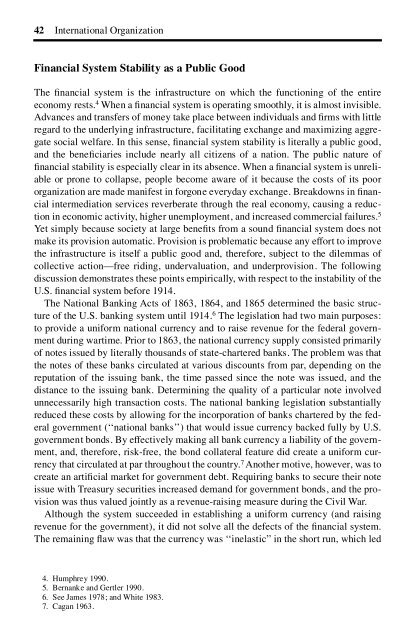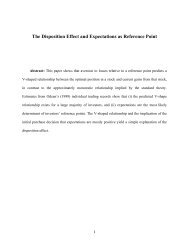Origins of the Federal Reserve System - Division of Social Sciences
Origins of the Federal Reserve System - Division of Social Sciences
Origins of the Federal Reserve System - Division of Social Sciences
You also want an ePaper? Increase the reach of your titles
YUMPU automatically turns print PDFs into web optimized ePapers that Google loves.
42 International Organization<br />
Financial <strong>System</strong> Stability as a Public Good<br />
The � nancial system is <strong>the</strong> infrastructure on which <strong>the</strong> functioning <strong>of</strong> <strong>the</strong> entire<br />
economy rests. 4 When a � nancial system is operating smoothly, it is almost invisible.<br />
Advances and transfers <strong>of</strong> money take place between individuals and � rms with little<br />
regard to <strong>the</strong> underlying infrastructure, facilitating exchange and maximizing aggregate<br />
social welfare. In this sense, � nancial system stability is literally a public good,<br />
and <strong>the</strong> bene� ciaries include nearly all citizens <strong>of</strong> a nation. The public nature <strong>of</strong><br />
� nancial stability is especially clear in its absence. When a � nancial system is unreliable<br />
or prone to collapse, people become aware <strong>of</strong> it because <strong>the</strong> costs <strong>of</strong> its poor<br />
organization are made manifest in forgone everyday exchange. Breakdowns in � nancial<br />
intermediation services reverberate through <strong>the</strong> real economy, causing a reduction<br />
in economic activity, higher unemployment, and increased commercial failures. 5<br />
Yet simply because society at large bene� ts from a sound � nancial system does not<br />
make its provision automatic. Provision is problematic because any effort to improve<br />
<strong>the</strong> infrastructure is itself a public good and, <strong>the</strong>refore, subject to <strong>the</strong> dilemmas <strong>of</strong><br />
collective action—free riding, undervaluation, and underprovision. The following<br />
discussion demonstrates <strong>the</strong>se points empirically, with respect to <strong>the</strong> instability <strong>of</strong> <strong>the</strong><br />
U.S. � nancial system before 1914.<br />
The National Banking Acts <strong>of</strong> 1863, 1864, and 1865 determined <strong>the</strong> basic structure<br />
<strong>of</strong> <strong>the</strong> U.S. banking system until 1914. 6 The legislation had two main purposes:<br />
to provide a uniform national currency and to raise revenue for <strong>the</strong> federal government<br />
during wartime. Prior to 1863, <strong>the</strong> national currency supply consisted primarily<br />
<strong>of</strong> notes issued by literally thousands <strong>of</strong> state-chartered banks. The problem was that<br />
<strong>the</strong> notes <strong>of</strong> <strong>the</strong>se banks circulated at various discounts from par, depending on <strong>the</strong><br />
reputation <strong>of</strong> <strong>the</strong> issuing bank, <strong>the</strong> time passed since <strong>the</strong> note was issued, and <strong>the</strong><br />
distance to <strong>the</strong> issuing bank. Determining <strong>the</strong> quality <strong>of</strong> a particular note involved<br />
unnecessarily high transaction costs. The national banking legislation substantially<br />
reduced <strong>the</strong>se costs by allowing for <strong>the</strong> incorporation <strong>of</strong> banks chartered by <strong>the</strong> federal<br />
government (‘‘national banks’’) that would issue currency backed fully by U.S.<br />
government bonds. By effectively making all bank currency a liability <strong>of</strong> <strong>the</strong> government,<br />
and, <strong>the</strong>refore, risk-free, <strong>the</strong> bond collateral feature did create a uniform currency<br />
that circulated at par throughout <strong>the</strong> country. 7 Ano<strong>the</strong>r motive, however, was to<br />
create an arti� cial market for government debt. Requiring banks to secure <strong>the</strong>ir note<br />
issue with Treasury securities increased demand for government bonds, and <strong>the</strong> provision<br />
was thus valued jointly as a revenue-raising measure during <strong>the</strong> Civil War.<br />
Although <strong>the</strong> system succeeded in establishing a uniform currency (and raising<br />
revenue for <strong>the</strong> government), it did not solve all <strong>the</strong> defects <strong>of</strong> <strong>the</strong> � nancial system.<br />
The remaining � aw was that <strong>the</strong> currency was ‘‘inelastic’’ in <strong>the</strong> short run, which led<br />
4. Humphrey 1990.<br />
5. Bernanke and Gertler 1990.<br />
6. See James 1978; and White 1983.<br />
7. Cagan 1963.



